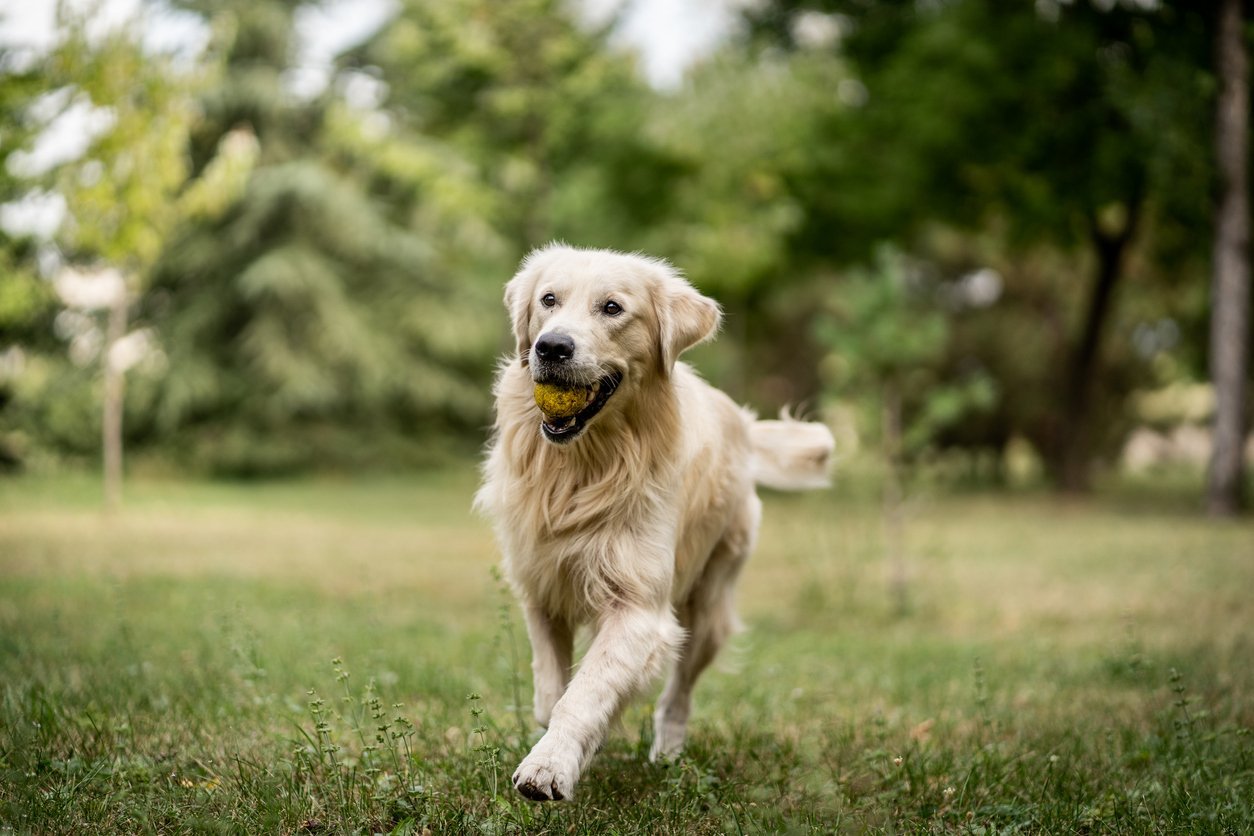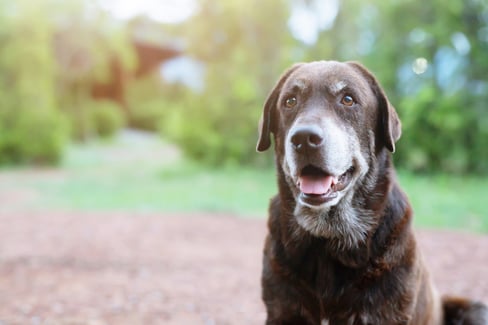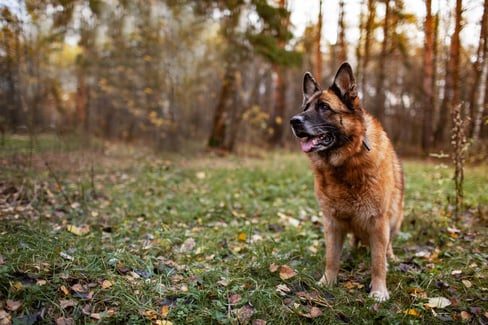Table of Contents
Golden retrievers have been a family favorite dog.
They’re affectionate, playful, social, good with kids, smart…we likely don’t need to go on because you already know your golden retriever is the definition of man’s best friend!
Sadly, our goldens are equally as prone to be a wonderful family pet as they are to golden retriever hip dysplasia.
In this post, we’re going to break down everything you need to know about hip dysplasia — from the symptoms of hip dysplasia in golden retrievers to how you can prevent and treat the condition to make sure your pup is happy well into their golden years.
So let’s get into hip dysplasia in golden retrievers 101! 🤓
Definition of Golden Retriever Hip Dysplasia
Before we get any further we’d better answer the question — what is golden retriever hip dysplasia?
hip dysplasia in dogs can be a difficult and painful condition. It occurs when your pup’s hips and hip joints don’t form quite right causing the hips to eventually dislocate.
But let’s back up for a second and get hip to how exactly a golden retriever’s rear joints work.
Just like in human hips, our canine pals have “ball-in-socket” hip joints. The “ball” is the femoral head in this case. The socket is where the femoral head fits and also articulates. In unaffected dogs, the femoral head fits tightly into properly formed sockets. But as you can see in the image below, when hip dysplasia sets in, the femoral head will flatten and won’t fit properly into the socket. In severe cases of hip dysplasia in golden retrievers, there can be partial dislocation and bone spurs present on the rims of the sockets and the femoral heads themselves.
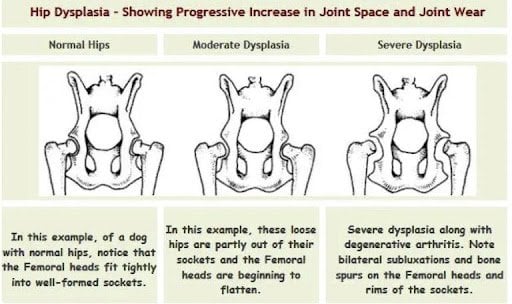
Since this condition affects the hips, you can imagine that your golden retriever’s movement could be anything from slightly to very painfully affected.
So are all golden retrievers likely to get hip dysplasia?
The short answer is no, but there’s more to it than that.
As purebreds, golden retrievers are more affected by this condition because the genes responsible for predisposition get passed down, and research hasn’t caught up with which exact genes can be credited with the disorder. However, according to the OFA’s ongoing data collection survey, almost 20% of golden retrievers have abnormal hips. This survey has been tracking the prevalence of hip dysplasia since 1994 and allows you to examine the severity and frequency of hip abnormalities over time.
We do know that golden retrievers are among other large breeds like Great Danes, German Shepherds, and Saint Bernards as being dogs that are primarily affected by hip dysplasia due to their size and breed characteristics.
But there are some environmental factors that contribute to the likelihood of a golden retriever with hip dysplasia as well.
Excessive, quick growth, too much exercise, the wrong nutrition, and injuries to their joints are all factors that will determine if and how much golden retriever hip dysplasia could affect your pup.
Golden Retriever Hip Dysplasia Signs
If you’re reading this post, you may already suspect you have a case of golden retriever hip dysplasia on your paws.
But if you aren’t familiar with the symptoms of hip dysplasia in golden retrievers, we’ve got them here so you can keep an eye on your golden retriever and catch hip dysplasia symptoms before it makes life ruff for your pup.
The first symptoms of hip dysplasia in golden retrievers you may notice could include:
- Won’t exercise as normal
- Swaying or “bunny-hopping” gait particularly upstairs
- Stiffness and visible pain
- Trouble or slowness going from sitting to a standing position
- Laying or sitting in a “frog” position where one leg splays out
- General reluctance to play, run or jump
- Winces or whines when the affected area is touched
- Lame hind legs
- Narrow stance in back legs
As the symptoms of hip dysplasia in golden retrievers worsen, you can typically spot the following signs from your dog:
- Muscular atrophy in the hind legs
- Dog arthritis symptoms such as limping, stiff or swollen joints, lethargy
- Will resist pets, won’t want to be touched
- Unexplained aggressive behaviour.
Golden Retriever Hip Dysplasia Prevention Tips

Your golden retriever is your family, and no one wants to see someone they love in pain. naturally, you’re probably looking for some golden retriever hip dysplasia prevention tips.
While there is nothing you can truly do to 100% prevent hip dysplasia in golden retrievers, you can help prevent the painful symptoms from reducing your golden’s quality of life.
Here is a list of some hip dysplasia prevention tips, so you can be proactive in protecting your golden’s joint health
Dog Joint Supplements
There’s nothing like starting your prevention from the inside out!
Since hip dysplasia can occur when joints don’t set up properly as your golden grows, incorporating a joint supplement into your golden’s diet can work to support healthy joint growth, reducing the chances of developing dysplasia later in life.
Supplements like TRI-ACTA offer a ton of benefits to your pup, like:
- Repairs their joint cartilage.
- Prevents further breakdown in the joints.
- Reduce pain and inflammation in their hips.
- Improve the lubrication of the hip joints.
Adding a joint supplement also helps your golden retriever with hip dysplasia to avoid further pain, so even if your golden has already developed this condition, supplements can offer tremendous benefits. But making sure you know how to read a supplement label is important so you can pick the right joint supplement for your beloved pet.
Low Strain Exercises
Golden Retrievers are sometimes referred to as “gentle giants” who love to play and socialize.
That means they love to get outside when possible and are just a little extra prone to excited zoomies around the house.
But you have to be careful with your pup — getting the right amount and type of exercise is important if you are looking to prevent golden retriever hip dysplasia.
Giving your puppy too much hard exercise like jogging, bike riding, agility, or hiking can further increase their risk of hip dysplasia.
Plus, young and clumsy puppies are more prone to injuries, and more injury to the joints may mean an increased likelihood of developing golden retriever hip dysplasia.
Instead of sporadic, intense exercise, your pup needs exercise that is:
- Consistent and low-impact
- Allows them to stay on a leash
- Promotes the stretching of hip joints
Not sure where to start? We assembled some good types of exercise for golden retriever hip dysplasia prevention perfect for golden puppies in the table below, as well as why it’s beneficial to your dog.
| Type of Exercise | Typical Duration | Benefits |
| Swimming | 20-30 minutes per session |
|
| Leash Walks | Several short, slow walks per day (less than 20 minutes per walk) |
|
| Underwater Treadmill Walks | As suggested by your canine rehabilitation expert |
|
| Agility Training/Games | Short sessions of 10-15 minutes at a time |
|
Healthy Diet
The old saying goes, “it’ll go right to my hips!” is especially true when it comes to golden retriever hip dysplasia prevention.
As hard as it is to say no to just one more treat, your golden retriever needs you to stay strong — how much they eat as a puppy can determine the likelihood of having hip dysplasia as they grow older.
One study focused on two groups of golden retriever puppies. One group was allowed to eat as much as they wanted during puppyhood. The other was subject to some portion control. The results showed that the controlled eating group had a 30% less incidence of golden retriever hip dysplasia than the group that ate as they pleased.
That’s barking mad if you ask us!
Talk to your vet about what the right portion size for your golden should be if you aren’t sure. But the overall message is clear — you need to make sure your golden retriever doesn’t overeat to keep weight down and to prevent their hips from growing too fast and getting malformed.
Injury Prevention
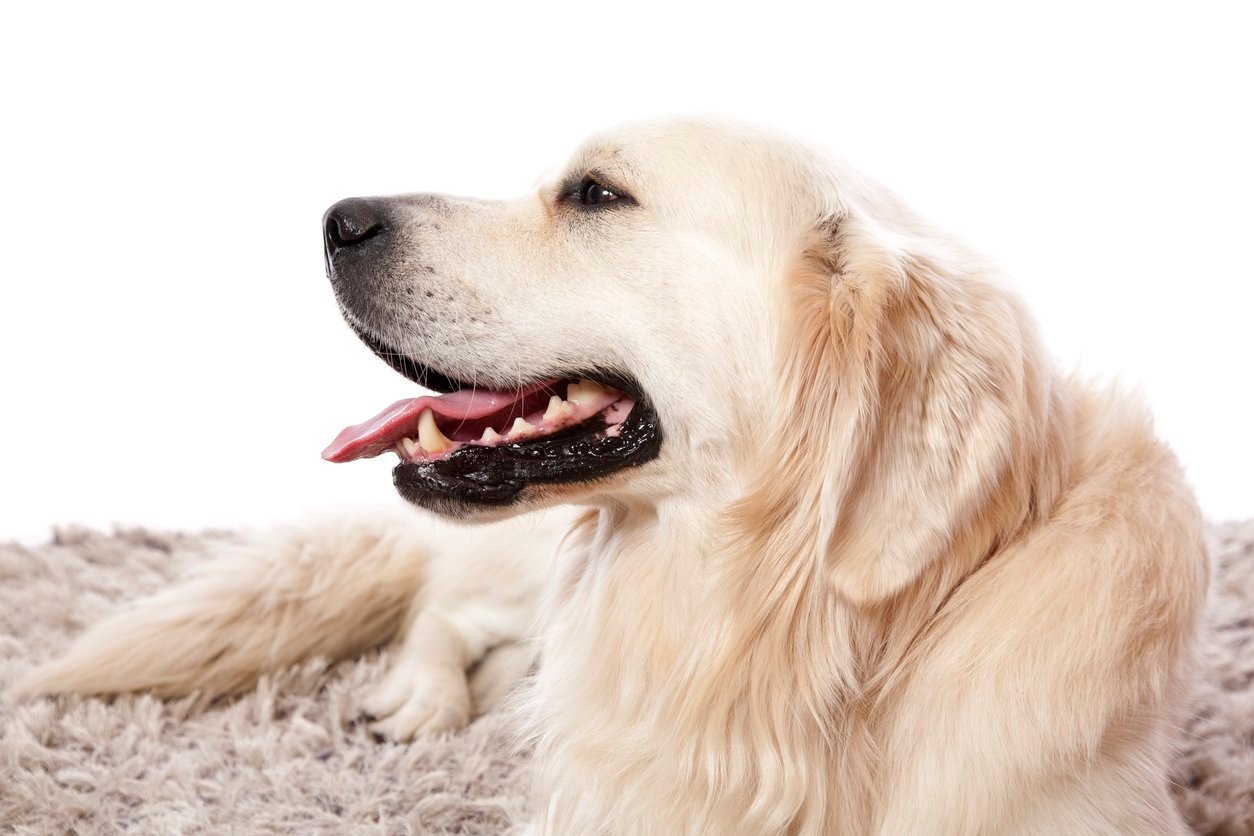
Last but not least is preventing injuries, which in turn helps prevent golden retriever hip dysplasia.
By reducing the number of ligament strains and injuries your pup experiences, you’re also reducing the likelihood of your pup developing hip dysplasia.
When your golden gets an injury, their femur can become misaligned, or come out of the socket, and the supporting structures may also suffer injuries. This can create extra strain on the joint because of the lack of support. Sounds pretty ruff if you ask us.
You can avoid injuries by doing some of the following:
- Add mats and rugs if you have hard (and slippery to your pup) floors
- Don’t allow them to jump on and off furniture, and use ramps if you want them to snuggle up on the couch so they avoid the harsh landing
- Be cautious when playing and avoid frisbees and balls thrown high in the air
- Keep them on a leash or contained when outdoors to avoid a squirrel chase gone wrong, or a run into traffic
Golden Retriever Hip Dysplasia Treatment Options
There isn’t one magical thing you can do to fully prevent golden retriever hip dysplasia, so golden retriever hip dysplasia treatment options are important to understand so you know what to do if your pup ends up afflicted.
We put together a list of the most common treatment options for golden retriever hip dysplasia but always start your treatment plan with a trip to the veterinarian.
1. Surgery
As hard as it is to see your sweet golden retriever pup go under the knife, surgery is sometimes the best option when your pup has a severe case of golden retriever hip dysplasia.
When it comes to surgery, there are different types, or levels, of surgical treatment for golden retriever hip dysplasia. Depending on your pup’s needs, your vet will determine which, if any, surgery would benefit your pup.
The table below outlines typical options for surgery.
| Surgery for Golden Retriever Hip Dysplasia | When is Surgery Recommended? | How it Works |
| Juvenile Pubic Symphysiodesis | For Golden Retrievers less than 5 months old |
|
| Triple Pelvic Osteotomy (TPO) | For Golden Retrievers less than 10 months old |
|
| Femoral Head Ostectomy (FHO) and Neck Excision | For seniors or lighter in weight Golden Retrievers |
|
| Total Hip Replacement (THP) | For fully grown Golden Retrievers in severe hip dysplasia. |
|
2. Physical Therapy

Whether your canine is undergoing one of the surgeries we mentioned or is in the earlier stages of golden retriever hip dysplasia, physical therapy can be really helpful for easing your pup’s discomfort.
This golden retriever hip dysplasia treatment can be done at a canine rehabilitation center, with an at-home regimen, or a combination of both.
Regular exercise, and stretching their hip joints are examples of therapies that work to pressure on the joints. And just like for humans, the treatment goals for every golden retriever will differ, as will their treatment plans.
Common physical therapies include:
- Exercise
- Cryotherapy
- Hot packs (placed on the affected area)
- Hydrotherapy
- Canine massage
Physical therapies should always come from a canine professional. Before you try any therapies on your pup at home, ensure you’re being taught the proper way to do them to make sure they are helping and not hurting your pet.
3. Anti-Inflammatory Medications
Another option for golden retriever hip dysplasia treatment is anti-inflammatory medications.
These medications offer our pups the ability to get relief from their pain quickly, and with ease. Medications work to reduce the inflammation inside the joint and make your pup perk up in a matter of a single dose.
Commonly prescribed options for golden retriever hip dysplasia treatment include:
- Deracoxib
- Carprofen
- Metacam
- Firocoxib
- Grapiprant
Be careful — as great as these medications are for both before strenuous activity and after for recovery, but they can have unpleasant or even dangerous side effects such as vomiting, decreased to no appetite, decreased activity level, and diarrhea. Monitor your golden retriever closely and always consult with your vet if you notice something is off about their behaviour after taking these prescribed medications.
4. Joint Supplements
Finally on the list of golden retriever hip dysplasia treatment options is joint fluid modifiers, also known as joint supplements.
When you’re helping ease the pains of golden retriever hip dysplasia, a multi-pronged approach created in consultation with your vet is helpful because it tackles the problem in more than one way.
Joint fluid modifier supplements like TRI-ACTA H.A. are perfect for helping speed along with the recovery of surgery and work alongside other golden retriever hip dysplasia treatments because they contain ingredients that help lubricate, repair, and reduce inflammation in the joint.
Glucosamine for dogs, among other joint health superhero ingredients, is something that can assist in golden retriever hip dysplasia treatment.
Check out what exactly those ingredients are, and how they benefit your golden retriever with hip dysplasia in the table below.
| Active Ingredient | Benefit |
| Glucosamine | Builds and repairs cartilage in the hip joint. |
| MSM | Reduces pain and inflammation. |
| Chondroitin | Prevents cartilage from further breakdown. |
| Hyaluronic Acid | Helps with lubricating the joint and increases joint fluid viscosity. |
Top 4 Dog Joint Supplements in the Market
When it comes to your golden retriever, you want to give them the best, so naturally, you’re going to need to know what the very best supplements are for their hip dysplasia.
With all we have covered so far in our back pockets, we’re going to review the best supplements for golden retriever hip dysplasia.
So let’s get started!
1. Integricare’s TRI-ACTA H.A.
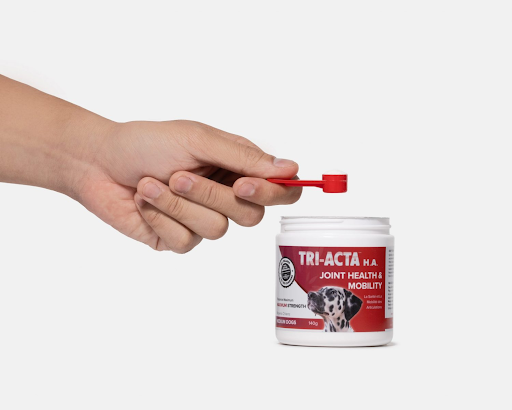
You could also say we’re playing favourites but the reason Integricare’s TRI-ACTA H.A. is number one on this list is that it has the TRI-ACTA advantage on its side.
This includes the following features and benefits for your golden retriever with hip dysplasia:
- 100% active ingredients and no fillers
- All-natural ingredients
- Therapeutic dosage of each ingredient
- Small serving size is easier to administer
- Economical, low cost per serving
- Pharmaceutical grade components
- Health Canada designated Veterinary Health Product (VHP)
As we said, we believe our products are the best for good reason. Many of the other products on this list can’t offer your pup the same high-quality, therapeutic dose in an easy-to-serve formula TRI-ACTA does. Plus, you can serve it to your feline companions, too, making it even easier on your wallet.
TRI-ACTA H.A. for Pets
Our maximum strength formula is optimally designed to accelerate the formation of cartilage, minimize inflammation, expedite the healing process, and improve joint conditions.
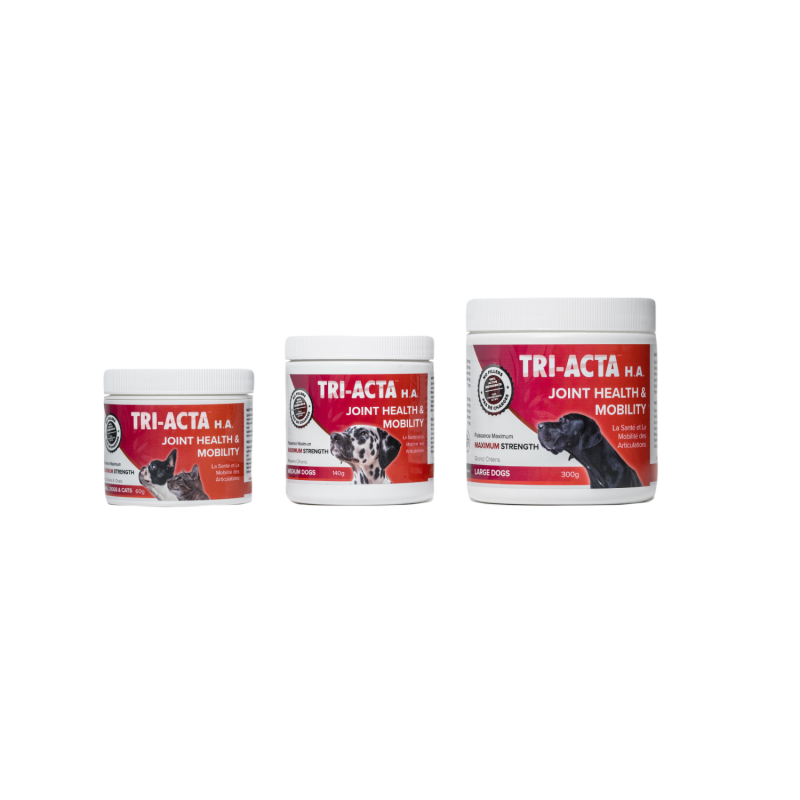
* Priced $27.99 – $79.99 CAD as of January 2022
2. GeriActive Soft Chews
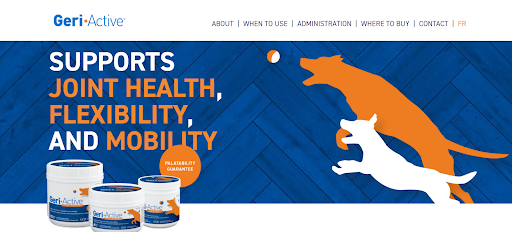
Next up on the list of top joint supplements for hip dysplasia is GeriActive’s Soft Chews. These are easy to administer to your pet and offer glucosamine and MSM alongside other supportive ingredients like creatine and collagen extracts. These supplements are offered in two formats, one for large dogs and one for small dogs (your golden will likely need the large dog formula).
One thing we’d caution is that soft chews may sound appealing (these even offer a so-called guarantee), but not all pet pawrents would agree that these treat-style supplements are accepted easily by their pets. It’s simply up to your pet’s palate to decide whether or not they will take their supplements, which isn’t great for your pocket if they end up rejecting the formulation!
* Priced $39.99 – 92.49 CAD as of January 2022
3. Brad Pattison Wellness Hip & Joint Care Soft Chews
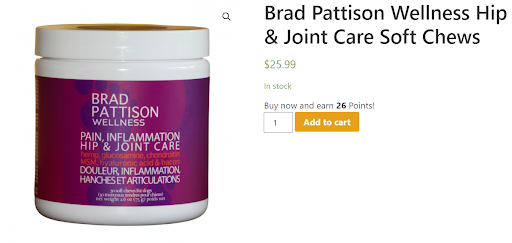
Next on the list is Brad Pattison Wellness Hip & Joint Care Soft Chews.
Also offered as an easy-to-eat soft-chew, this supplement is packed with all the ingredients we love — glucosamine, chondroitin, hyaluronic acid, and MSM — with a bacon flavour your pup will adore. It does include hemp as an ingredient, however, as well as a pretty lengthy list of inactive ingredients like chickpea flour and molasses, so you’re getting less therapeutic value than we’d like to see per dose.
* Priced $25.99 CAD as of January 2022
4. Zesty Paws Mobility Chews for Dogs

Coming in at number 4 on the list, we have Zesty Paws Mobility Chews for Dogs. These flavoured treats will delight your pup’s taste buds while giving them a dose of glucosamine, MSM, chondroitin, and Vitamin C & E.
Be warned, however. This product contains quite a few inactive ingredients and can only be used for dogs, and not cats. So you certainly won’t be saving any money by using one product for both pets, and you’re missing out on pure, therapeutic doses of those important ingredients like we just mentioned.
* Priced $34.46 CAD as of January 2022
Q&A
How Much Does Golden Retriever Hip Dysplasia Surgery Cost?
Golden Retriever Hip Dysplasia Surgery Costs can range. It depends on the type of hip dysplasia surgery your golden requires and if it is one hip, or two. Generally, the costs for this can be anywhere from $1,700 to $4,500 or more.
What Age is Most Common for Golden Retrievers to Develop Hip Dysplasia?
For golden retrievers, like other canines, hip dysplasia can onset as early as when they are just a few months old, but more likely, your dog will show signs around age one to two.
What Is Golden Retriever Hip Dysplasia Certification?
In order to screen out hip dysplasia from breeding dogs, or to know what your pup could face later in life, you can undergo screening like PennHIP or the screening certification from the OFA (Orthopedic Foundation for Animals) to find out if your golden has hip dysplasia in their future, and to help you prepare their joints accordingly.
What Hip Dysplasia Golden Retriever Symptoms Should I Look For?
Like we mentioned earlier, there are some hip dysplasia golden retriever symptoms you need to look for. These will look similar to arthritis, with your dog suffering from slow movement, painful joints, and stiffness in general. If you see your dog acting this way, it may be time to call the vet for a checkup.
Final Thoughts

While you can’t guarantee your golden retriever won’t ever get hip dysplasia, you can take the steps needed to make their lives more comfortable, and even get a full range of motion back with the right combination of treatment options if golden retriever hip dysplasia becomes severe.
No matter what the combination of treatment and prevention you and your vet decide is best for your golden, adding a joint health supplement like TRI-ACTA or TRI-ACTA H.A. can help maintain overall joint health and help reduce some of the painful symptoms of hip dysplasia in golden retrievers.
Find out more about helping your dog live a healthy life on our blog and find out where to buy our products.
Newsletter Signup
Subscribe to our newsletter to receive the latest news and exclusive offers.
.jpg?height=2000&name=Cliick_Integricare-DISPLAY-REVISEDV2%20(1).jpg)
Proactive & Therapeutic Joint Supplements
When given daily, Integricare joint supplements recover bone and joint injuries faster and help prevent mobility injuries from happening in the first place.

